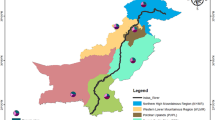Abstract
The Poaceae family includes approximately 700 genera and 10 000 species, and Mexico is considered one of its most important centers of diversity and endemism. A total of 256 taxa (including 16 subspecific taxonomic units), belonging to 65 genera, are endemic to Mexico. Some of them are close relatives of important crops, while others are used in different ways all over the country. The aim of this paper is to discuss the distribution patterns at state level of the Mexican endemic species of Poaceae. Using cluster strategies, the states are classified according to their floristic similarities. Later, hotspots of endemism are identified, in order to discuss their role in conservation strategies. To evaluate the importance of each state in the conservation of the Mexican endemic Poaceae, two iterative complementarity methods were also used. Our results show that the largest concentration of endemic taxa occurs in a few states, such as Jalisco, Mexico, Michoacán, Durango, Oaxaca, Veracruz, San Luis Potosi, Chiapas, Chihuahua, Puebla, and Coahuila. The results also show that there are some patterns in the relationship to its endemism that seem to reflect important diversification trends in the family. Accordingly, 31% of the grass genera of Mexico have at least one endemic species, and 16.7% of the genera have only one endemic species. In contrast, six genera contribute 47.2% of the total number of grass endemics in Mexico. The Chloridoideae contributes 42.9% of the total grass endemic species of Mexico, whereas the Panicoideae includes 24.6%, and the Pooideae 19.8%. Thus, these three subfamilies contribute about 87% of the species endemism. On the basis of the habitat and distribution patterns of these subfamilies, two main areas of endemicity can be identified. The first area is located in warm habitats, whereas the second is related to temperate and high regions. The cluster analyses indicate the occurrence of four state groups whose phytogeographical explanation is discussed on the basis of a floristic regionalization of Mexico. The results also indicate the need to establish a relatively high number of sites and states for the conservation of 256 endemic taxa. The elevated number of sites required to conserve the Mexican endemic Poaceae is mainly due to the fact that many taxa have a restricted distribution pattern. On the basis of the patterns obtained, a few proposals are presented for undertaking the establishment of conservation priorities of these taxa.
Similar content being viewed by others
References
Clayton W.D. and Renvoize S.A. 1983. Genera graminum: grasses of the world. Kew Bulletin. Additional Series XIII. Her Majesty's Stationery Office, Royal Botanical Gardens, Kew, UK, 387 pp.
Daniel T.F. 1998. Mexican Acanthaceae: diversity and distribution. In: Ramamoorthy T.P., Bye R., Lot A. and Fa J.A. (eds) Biological Diversity of Mexico, Origins and Distribution. Oxford University Press, New York, pp. 541-558.
Delgadillo C., Villaseñor J.L. and Dávila P. 2003. Endemism in the Mexican flora: a comparative study in three plant groups. Annals of the Missouri Botanical Garden 90: 25-34.
Judziewickz E.J., Soreng R.J., Davidse G., Peterson P.M., Filgueiras T.S. and Zuloaga F.O. 2000. Catalogue of New World grasses (Poaceae): I. Subfamilies Anomochlooideae, Bambusoideae, Ehrhaartoideae, and Pharoideae. Contributions of the U.S. National Herbarium 39: 1-128.
Lira R., Villaseñor J.L. and Ortíz E. 2002. A proposal for the conservation of the family Cucurbitaceae in Mexico. Biodiversity and Conservation 11: 1699-1720.
Mejía-Saulés M.T. and Dávila P. 1992. es Gramíneas útiles de México. Cuadernos del Instituto de Biología. 16. Instituto de Biología, Universidad Nacional Autónoma de México, México.
Peterson P.M., Soreng R.J., Davidse G., Filgueiras T.S., Zuloaga F.O. and Judziewicz E.J. 2001. Catalogue of New World grasses (Poaceae): II. Subfamily Chloridoideae. Contributions of the U.S. National Herbarium 41: 1-255.
Pressey R.L., Humphries C.J., Margules C.R., Vane-Wright R.L. and Williams P.H. 1993. Beyond opportunism: key principles for systematic reserve selection. Trends in Ecology and Evolution 8: 124-128.
Preston F.W. 1948. The commonness and rarity of species. Ecology 29: 254-283.
Ramamoorthy T.P. and Elliott M. 1998. Mexican Lamiaceae: diversity, distribution, endemism, and evolution. In: Ramamoorthy T.P., Bye R., Lot A. and Fa J.A. (eds) Biological Diversity of Mexico, Origins and Distribution. Oxford University Press, New York, pp. 513-539.
Rebelo A.G. 1994. Iterative selection procedures: centres of endemism and optical placement of reserves. Strelitzia 1: 231-257.
Rohlf F.J. 1997. NTSYS. Numerical Taxonomy and Multivariate Analysis System. Version 2.0. Applied Biostatistics Inc., New York.
Rzedowski J. 1978. Vegetación de México. Limusa, México D.F.
Rzedowski J. 1991. Diversidad y orígenes de la flora fanerogámica de México. Acta Botánica Mexicana 14: 3-21.
Sousa M. and Delgado A. 1993. Mexican Leguminosae: phytogeography, endemism, and origins. In: Ramamoorthy T.P., Bye R., Lot A. and Fa J.A. (eds) Biological Diversity of Mexico, Origins and Distribution. Oxford University Press, New York, pp. 459-511.
Turpie J.K., Beckley L.E. and Katua S.M. 2000. Biogeography and the selection of priority areas for conservation of South African coastal fishes. Biological Conservation 92: 59-72.
Valdés J. and Dávila P. 1995. Clasificación de los géneros de gramíneas (Poaceae) mexicanas. Acta Botánica Mexicana 33: 37-51.
Vane-Wright R.I., Humphries C.J. and Williams P.H. 1991. What to protect? Systematics and the agony of choice. Biological Conservation 55: 235-254.
Villaseñor J.L. 1990. The genera of Asteraceae endemic to Mexico and adjacent regions. Aliso 12: 685-692.
Villaseñor J.L. and Espinosa F.J. 1998. Catálogo de Malezas de México. UNAM-Fondo de Cultura Económica, México, D.F.
Villaseñor J.L., Ibarra G. and Ocaña D. 1998. Strategies for the conservation of Asteraceae in Mexico. Conservation Biology 12: 1066-1075.
Author information
Authors and Affiliations
Corresponding author
Rights and permissions
About this article
Cite this article
Dávila-Aranda, P., Lira-Saade, R. & Valdés-Reyna, J. Endemic species of grasses in Mexico: a phytogeographic approach. Biodiversity and Conservation 13, 1101–1121 (2004). https://doi.org/10.1023/B:BIOC.0000018147.54695.b3
Issue Date:
DOI: https://doi.org/10.1023/B:BIOC.0000018147.54695.b3




